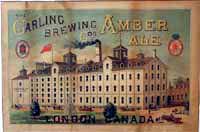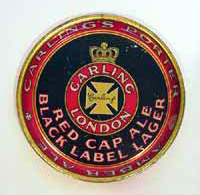


Sir John Carling was born on a farm in London Township near Hyde Park in 1828. Carling's father, Thomas, immigrated from Yorkshire in 1818, putting him among the earliest settlers in the Township.
After twenty years of farming, the Carling family relocated to London where Thomas Carling opened a brewery on Waterloo north of Pall Mall. Around 1849 Thomas Carling's sons William and John took over the brewery, now known as W. and J. Carling's City Brewery.  Bottling both ale and porter, by 1860 the brewery was using 18-20,000 bushels of grain a year, 12-18,000 pounds of hops and malting 22,000 bushels of barley a season. "The proprietors give steady employment to between 15 and 20 men" runs a description written about 1860, "and six horses are constantly employed in connection with the establishment. The works are propelled by a steam engine. Agencies have been opened in Chatham, Sarnia, Newbury, Bothwell, St. Thomas, Ingersoll, Seaforth, Goderich, Exeter and Windsor. Beer and ale has been sent frequently to Hamilton and Toronto." Bottling both ale and porter, by 1860 the brewery was using 18-20,000 bushels of grain a year, 12-18,000 pounds of hops and malting 22,000 bushels of barley a season. "The proprietors give steady employment to between 15 and 20 men" runs a description written about 1860, "and six horses are constantly employed in connection with the establishment. The works are propelled by a steam engine. Agencies have been opened in Chatham, Sarnia, Newbury, Bothwell, St. Thomas, Ingersoll, Seaforth, Goderich, Exeter and Windsor. Beer and ale has been sent frequently to Hamilton and Toronto."
 In 1875 the brothers abandoned the old brewery and moved to the corner of Ann and Talbot Streets, further down the small creek that now bore their name. Here, directly over a never failing source of spring water, they built one of the largest breweries in Canada. In 1875 the brothers abandoned the old brewery and moved to the corner of Ann and Talbot Streets, further down the small creek that now bore their name. Here, directly over a never failing source of spring water, they built one of the largest breweries in Canada.
John's son, Thomas H. (or T. Harry), soon joined the brewery and all looked bright until a February, 1879 fire gutted the new building. The fire, which appeared at one point to be under control, set off a terrific explosion (probably caused by malt dust) that opened up the centre of the building and restarted the flames. Despite the explosion, the building's walls were still sound and the brewery was rebuilt. However, as a result of directing fire-fighting efforts in the frigid February weather, William fell victim to pneumonia and died days later.
The company rebounded after the fire with the help of investment from outside the family and with T.H remaining as manager. By 1890, Carling and Labatt's were about the same size, capable of putting out about 30,000 barrels of ale and porter, a year. Carling also produced lager. At this time, Carling employed about 100 men and Labatt's 70. |
 |  |
|